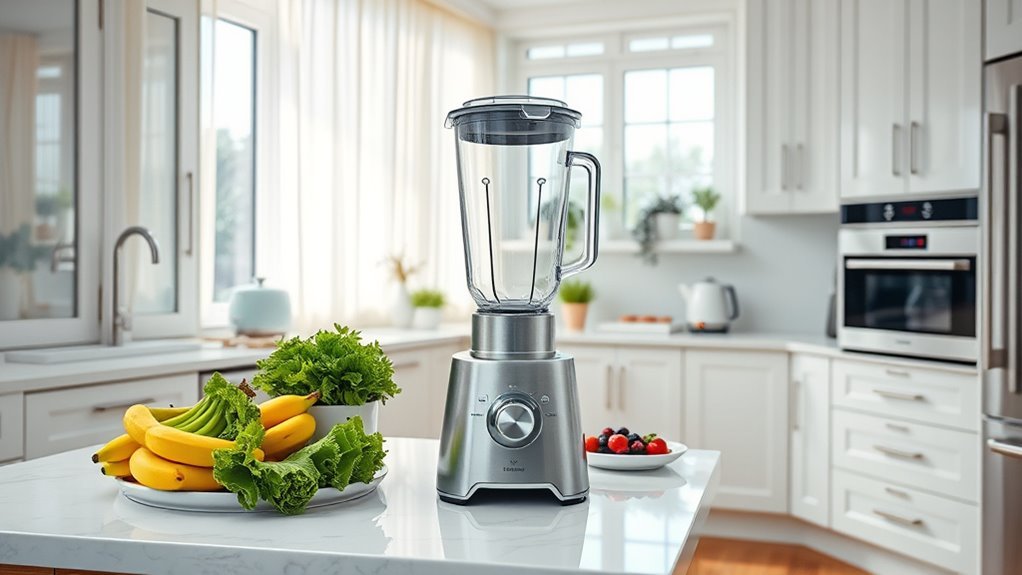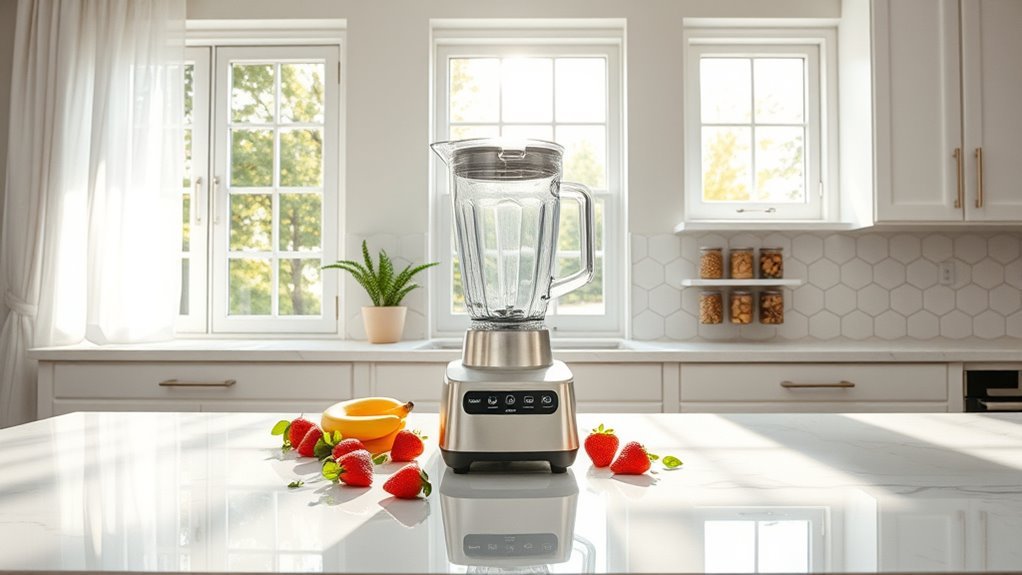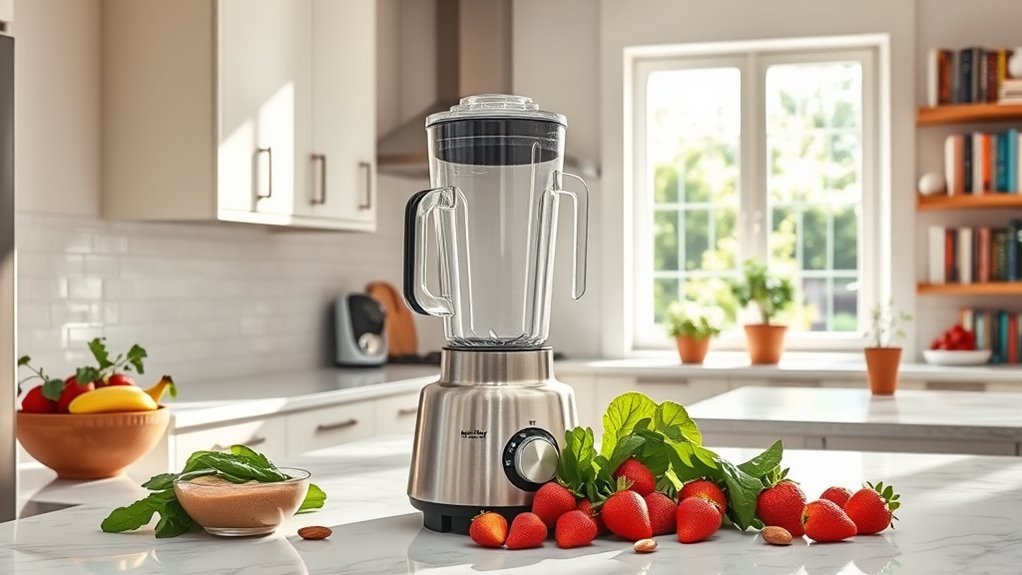We’ll start at 30% speed to properly incorporate emulsifying agents, then gradually increase every 30 seconds. Watch for foam formation and adjust accordingly – aim for 50-70% max speed for ideal results. For thick emulsions, maintain steady low speeds; for light and airy ones, use short high-speed bursts. Monitor RPM (1000-3000 range), temperature, and vibration patterns. Master these basics, and you’ll reveal the secrets to silky-smooth emulsions.
Start Low and Gradually Increase Speed

When creating perfect emulsions, speed control can make or break your results.
We’ll start at a low speed – around 30% of maximum – to properly incorporate the emulsifying agent without trapping excess air. Trust us, you don’t want a foamy mess on your hands.
Once we’ve achieved initial blending, we’ll gradually increase the speed every 30 seconds. This step-by-step approach helps guarantee even distribution of ingredients throughout both oil and water phases. We’re aiming for that sweet spot of 50-70% of maximum speed for ideal results.
Watch your mixture closely. If foam starts forming, dial it back immediately. Let the emulsion stabilize before ramping up again.
Remember: patience at the beginning means perfection at the end. Additionally, using a high-performance blender can enhance your emulsifying process by providing consistent results and smoother textures.
Master the Pulse Technique
Every skilled emulsion maker needs to master the pulse technique – it’s your secret weapon against over-mixing disasters. Let’s break down this critical method that’ll revolutionize your emulsion stability. We’re talking 5-10 second bursts at 50-60% power, with strategic pauses between pulses to let things settle. High-performance blenders, with their motor power, can significantly enhance your blending experience.
| Phase | Speed | Duration | Action | Result |
|---|---|---|---|---|
| Start | 50% | 5s | Pulse | Initial blend |
| Check | 0% | 3s | Rest | Stabilization |
| Mid | 55% | 7s | Pulse | Distribution |
| Assess | 0% | 3s | Rest | Evaluation |
| Final | 60% | 10s | Pulse | Completion |
Monitor texture constantly – you’ll need 1-5 minutes total, depending on your formula. Trust your eyes and adjust accordingly. No guesswork, just precision.
Match Speed to Emulsion Thickness

Building on our pulse technique mastery, let’s tackle the science of speed-matching your emulsions. The thickness of your mixture dictates the speed you’ll need – it’s that simple. For thick emulsions, we commonly used slower speeds to prevent unwanted air pockets and guarantee stability.
When your emulsion takes on a thinner consistency, crank up that speed. Higher RPMs help disperse those oil and water phases more effectively.
Here’s the key: watch your viscosity like a hawk and adjust accordingly. If you’re using high-shear emulsifiers, you’ll need to push those speeds up for proper dispersion.
That’s why we swear by variable speed mixers – they’re your best friend for fine-tuning the perfect emulsion, regardless of thickness.
Time Your Speed Transitions
Since proper timing can make or break your emulsion, you’ll need to master the art of speed changes.
We’ll start with a gradual increase in mixing speed when combining your emulsifiers – it’s vital for proper dispersion without trapping air bubbles that’ll wreck stability.
Let’s keep that moderate speed humming for 5-10 minutes. Trust us, this sweet spot creates consistency while keeping foam at bay.
Your speed control mechanism is your best friend here – jerky shifts are emulsion killers.
Watch your mixture’s thickness like a hawk; thicker emulsions need slower speeds to protect that delicate emulsifier structure.
Recognize Visual Speed Indicators

Now that we’ve mastered speed timing, let’s decode the visual cues that’ll tell you if you’re hitting the sweet spot. The most reliable visual speed indicators start with that telltale glistening surface – it’s your first sign of proper emulsion application.
When you’re nailing the speed, you’ll see the emulsion smoothly encapsulating those screen threads.
Watch for consistency in the coating’s appearance. If you’re seeing foam or air pockets, you’re moving too fast. A patchy, separated look? You’re dragging.
The emulsion’s viscosity is your guide – thicker formulations need a slower touch, while thinner ones can handle more speed.
Balance Temperature With Mixing Speed
While mixing speed sets the foundation for your emulsion, temperature control acts as its critical dance partner.
Let’s nail both variables: keep your room at 75-80°F for ideal emulsification, and maintain mixing speeds between 200-400 RPM.
We’re aiming for the sweet spot here. Higher speeds might seem tempting, but they’ll generate unwanted heat and potentially wreck your emulsifiers.
Stick to moderate mixing for 5-10 minutes – trust us, it’s enough.
And here’s a pro tip: before you even start mixing, get those emulsifiers fully dissolved by heating phases to no more than 140°F.
Watch your mixture’s viscosity like a hawk.
When temperature and speed align perfectly, you’ll see that satisfying consistency develop right before your eyes.
It’s science meets art, and we’re mastering both.
Adapt Speed for Different Ingredients
Different ingredients demand radically different mixing speeds – it’s a non-negotiable rule for perfect emulsions.
Here’s your ultimate guide to mastering speed control: When we’re working with thicker ingredients like emulsifiers, we’ll want to start slow and gradually increase speed. For oil-in-water emulsions, we make sure to use moderate speeds that disperse droplets without over-aerating the mixture.
Got delicate cosmetic emulsions? We’ll keep it slow and steady to prevent excess foam.
Cold ingredients? Dial back that speed until they warm up.
And when we’re tackling high-oil formulations, we’ll hit it hard initially to break down the oil phase, then ease off once stability kicks in.
Remember – proper speed control is the difference between silky smooth and sadly separated.
Monitor Motor Performance
Successful emulsification depends on keeping a close watch on your motor’s essential signs. Just like screen printing requires precise control, we’ll monitor motor performance through key metrics. Let’s break down what you need to track.
| Parameter | Normal Range | Warning Signs |
|---|---|---|
| RPM | 1000-3000 | Fluctuating speed |
| Temperature | Cool to warm | Hot to touch |
| Vibration | Minimal | Excessive shake |
We’re watching for three vital indicators: RPM stability, temperature, and vibration patterns. Use your digital ammeter to check current draw – it’s your early warning system. When current spikes above normal, you’ve got trouble brewing. Don’t skip those maintenance checks; worn bearings can turn your perfect emulsion into an expensive mess faster than you can say “downtime.”
Optimize Speed for Container Size
Matching container size to mixing speed creates the foundation for emulsion success.
We’ve got to choose the right speed based on volume – it’s critical for stability. For small containers, we keep speeds moderate to prevent excess air from ruining our emulsion. Larger batches? We’ll gradually ramp up speed for efficient mixing while maintaining control.
Time matters too. Small batches need less mixing, while bigger volumes require extended processing for uniform results.
That’s why we’ve always used variable speed equipment – it lets us dial in the perfect settings for any viscosity or volume.
Watch your mixture closely. If you spot streaking or separation, adjust speed or duration immediately. No guesswork here – visual monitoring is your fail-safe for achieving that perfect, stable emulsion every time.
Fine-tune Speed for Specific Textures
Getting the right texture in your emulsion starts with precise speed control.
We’ll help you master the art of speed adjustment for flawless results every time.
For thick, creamy emulsions, we keep mixing speed low and steady. This prevents unwanted air incorporation while ensuring thorough blending.
When working with high-viscosity emulsions, slower speeds are your best friend – they’ll give you that perfect, uniform consistency without separation.
Want something light and airy? Short bursts of high-speed blending will do the trick.
But don’t overdo it – excessive foaming is your enemy.
As you add emulsifiers, gradually increase the speed to prevent clumping.
We recommend starting slow, then ramping up as ingredients incorporate.
Watch the mixture closely – its behavior will tell you when to adjust.
Frequently Asked Questions
How to Improve the Stability of Emulsions?
We’ll improve emulsion stability by using proper emulsion additives and mixing techniques, ensuring complete dissolution, controlling temperature, monitoring pH levels, and following correct ingredient addition sequences during preparation.
What Key Factors Contribute to Successfully Creating and Stabilizing an Emulsion?
We’ll achieve stable emulsions through mindful ingredient selection, precise oil-to-water ratios, and proper emulsifier choices. Temperature control, consistent mixing, and correct phase addition guarantee perfect emulsion texture every time.
How to Prevent Flocculation in Emulsion?
We’ll prevent flocculation by ensuring complete emulsifier dissolution, maintaining proper oil-water ratios, monitoring pH levels, controlling mixing conditions, and storing our emulsion formulation under ideal environmental conditions.
What Is 4 2 1 Method of Preparing Emulsions?
Like a perfect dance, we’ll create emulsions using the 4-2-1 method: combine 4 parts oil, 2 parts water, and 1 part emulsifier with proper mixing techniques for ideal emulsion ratios.

